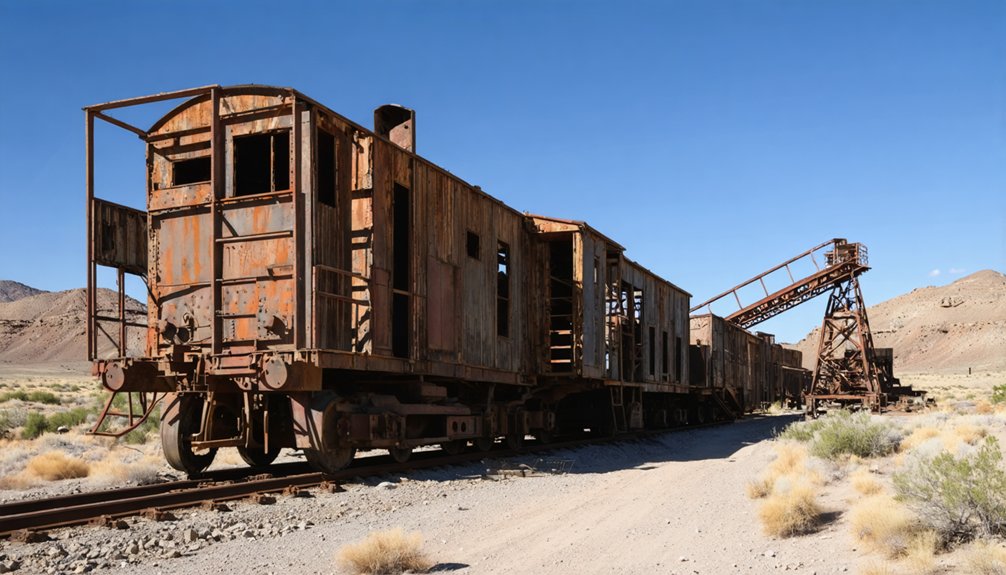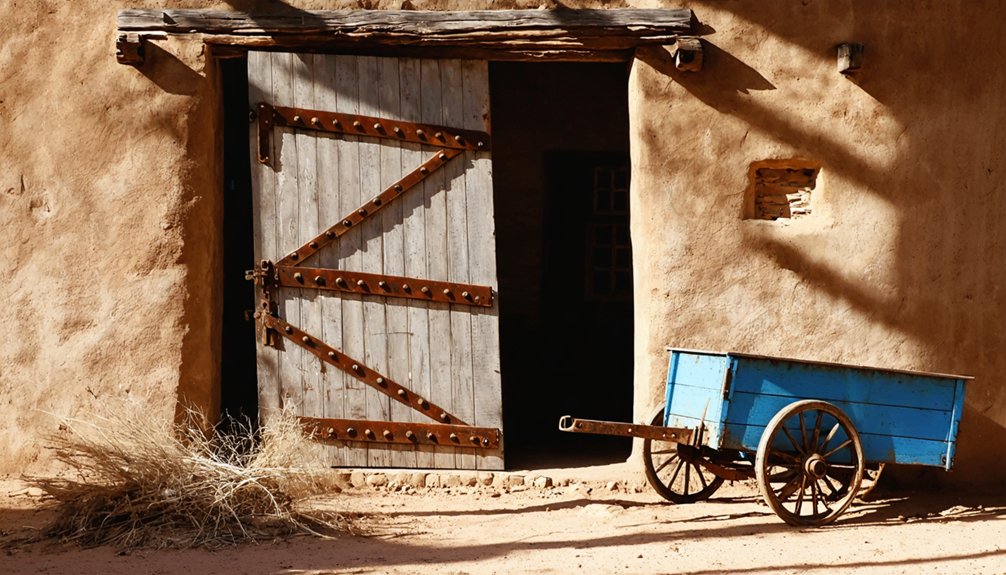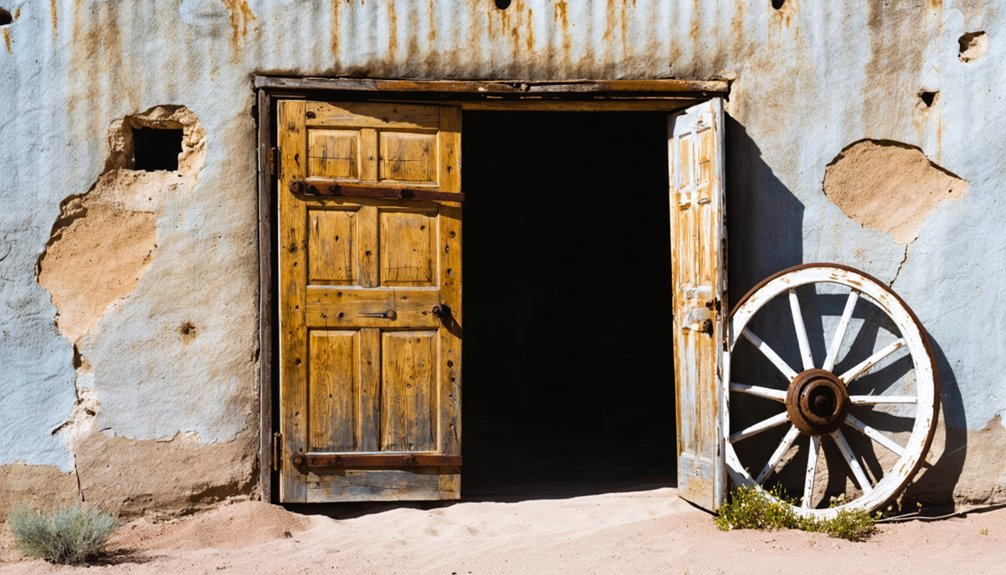Curtis, Arizona was established in the 1880s by prospectors Billy Gavin and Theodore Boggs along Big Bug Creek in Yavapai County. You’ll find this ghost town operated briefly as a copper mining hub with a post office that changed names from Apron Crossing to Arizona City. Phelps Dodge built a smelter here in 1889, but by 1893, depleted resources triggered mass exodus. The abandoned structures and mine shafts tell a story of boom-and-bust that shaped Arizona’s mining legacy.
Key Takeaways
- Curtis was established in the 1880s by prospectors Billy Gavin and Theodore Boggs along Big Bug Creek in Yavapai County.
- The town flourished during Arizona’s copper mining boom but collapsed rapidly after the smelter was abandoned in 1893.
- A post office operated as Apron Crossing (1891-1895) and was later renamed Arizona City in 1899.
- Daily life featured harsh working conditions with 10-12 hour underground shifts and limited safety practices.
- Today, deteriorating buildings, abandoned mine shafts, and scattered artifacts remain as testament to Curtis’s boom-and-bust history.
The Discovery and Naming of Curtis
In the shadow of the Bradshaw Mountains, Curtis emerged from the frontier dreams of “Uncle” Billy Gavin and Theodore W. Boggs.
These intrepid prospectors discovered the site in the 1880s along Big Bug Creek in Yavapai County, quickly establishing mining claims that would define the region’s future.
The settlement naturally took the name Curtis, following the tradition of mining towns across the American West.
Mining towns across the frontier followed naming conventions, with Curtis joining this distinctly American tradition.
As you’d explore the town during its heyday, you’d notice the typical frontier town layout, with structures positioned strategically to support various mining techniques.
Water from Big Bug Creek proved essential for these operations.
The town also became known as Apron Crossing, with its post office operating from 1891 to 1895, serving the growing mining community.
In 1889, mining development accelerated when Phelps Dodge purchased claims in the area and constructed a large smelter to process ore from local mines.
The Curtis name remained official until 1899, when a cunning mine promoter fraudulently renamed it Arizona City to attract fresh capital to the declining settlement.
Mining Boom Years: Rise of a Desert Community
As copper production surged across Arizona in the early 1880s, Curtis transformed from a modest mining claim into a bustling frontier community.
You’d find Arizona’s output skyrocketing from 2 million pounds of copper in 1880 to over 20 million by 1882, propelling the territory to become the nation’s second-largest producer.
The 1920s brought further prosperity when Apache Nitrogen Products began manufacturing dynamite, producing one million pounds monthly by 1923.
Railroad connections through the Curtiss rail stop enabled efficient transport of mining equipment and explosives, while improved roadways like the Apache Trail enhanced accessibility.
Despite economic downturns, the community demonstrated remarkable resilience.
Mining techniques evolved from transient prospecting to permanent operations, creating hundreds of jobs that sustained families through the Great Depression in this desert boomtown.
The area’s first major gold discovery in 1879 by two Mexican prospectors contributed significantly to the region’s mining reputation and subsequent development.
Safety was a persistent concern with numerous incidents including a major 1923 explosion at Apache Powder that resulted in four worker deaths and significant structural damage.
Daily Life in a 19th Century Mining Town
If you’d visited Curtis during its heyday, you’d have endured cramped living quarters in hastily constructed wooden shelters that huddled close to the mines, where water scarcity compounded the harsh desert conditions.
Your daily routine would have revolved around dangerous underground labor, traversing extensive tunnel networks while contending with explosive blasting and the constant threat of cave-ins.
After grueling shifts, you might’ve found respite in the town’s bustling commercial district, where saloons and general stores served as essential social hubs for the diverse community of miners and their families. The town was part of Arizona’s longest worked district, with mining operations continuing well into the 1970s. Many residents considered the local post office the heart of their community until its closure signaled the town’s eventual decline.
Harsh Living Conditions
Life in Curtis, Arizona demanded extraordinary resilience from its inhabitants, who faced daily challenges that modern Americans would find nearly unbearable.
You’d have struggled with scarcity challenges as basic necessities arrived by wagon trains traveling 15 miles through bandit-prone territory. Your cramped living conditions might’ve included ten family members sharing a single room in a hastily constructed wooden shelter or tent. The constant threat of Yavapai tribe attacks created a perpetual state of vigilance among residents. Similar to the Flying V Cabin at Pioneer Living History Museum, many homes featured gun slots for defense against raiders.
- Your water and food depended entirely on dangerous supply routes vulnerable to attack
- Your home offered little protection from scorpions, dust storms, and extreme desert heat
- You’d face constant fear of nighttime raids with minimal law enforcement protection
- Your children had no guarantee of medical care when mining accidents or disease struck
- Your wooden or mud dwelling deteriorated rapidly, emphasizing the town’s impermanence
Mining Workers’ Routines
While the whistle signaled the start of another grueling day at Curtis mining operations, you’d already be halfway through your breakfast of beans and hardtack, preparing for your 10-12 hour shift underground.
Before dawn, you’d descend into the darkness, first inspecting tunnels for cave-in risks and ensuring proper air circulation—minimal mine safety practices that often failed to prevent silicosis and gas poisoning. Similar practices were common in towns like Courtland, where copper mining companies employed thousands before their sudden decline in 1921.
Your main tasks involved backbreaking work with pickaxes, shovels, and dangerous dynamite blasting. Many miners dreamed of finding their fortune like the legendary Lost Dutchman Mine that had sparked countless treasure hunts.
When your shift ended, you’d emerge dust-covered and exhausted, pockets holding worker wages often paid in company scrip instead of real currency.
This system kept you tethered to the company store while Phelps Dodge claimed the real profits.
With medical care virtually nonexistent, you’d pray daily to avoid the accidents that regularly claimed miners’ lives.
Community Gathering Spaces
After exhausting shifts in the mines, Curtis residents found solace and connection in the town’s vibrant gathering spaces that formed the backbone of community life.
You’d discover the general store buzzing with daily social interaction, while the town’s saloon offered respite where miners unwound and shared stories.
Churches weren’t merely places of worship but centers for community events that united the diverse population.
The schoolhouse served dual purposes—educating children by day and hosting town meetings by night.
- The crackle of laughter echoing from the saloon on Saturday evenings
- The solemn unity of voices raised in song during church gatherings
- The heated debates during town hall meetings that shaped Curtis’s future
- The festive decorations transforming ordinary spaces during holiday celebrations
- The sweet anticipation of Sunday picnics where isolation briefly vanished
Phelps Dodge and Industrial Mining Operations

Although Curtis’s mining operations ceased in 1893, Phelps Dodge’s presence in Arizona had only begun to take root. The company established a smelter in Curtis in 1889, but abandoned the site when local resources were depleted just four years later.
Mining empires rise and fall, but Phelps Dodge’s brief Curtis venture only foreshadowed their coming Arizona dominance.
Phelps Dodge’s industrial advancements transformed Arizona mining from artisanal operations to massive enterprises. By 1921, they’d acquired Arizona Copper Company and Detroit Mining Company, consolidating their control over the region’s land, water, and timber resources.
Their technological innovations enabled profitable extraction from low-grade ores, meeting the rising copper demand for electrical infrastructure.
You can still see remnants of their influence in Curtis today, part of a legacy that brought both prosperity and conflict to Arizona mining communities through labor disputes and economic dominance.
The Decline: When the Minerals Ran Dry
You’re witnessing the brutal economics of resource depletion in Curtis, where once-bustling mine operations collapsed when copper prices plummeted after World War I, leaving millions in low-grade ore untouchable due to technological limitations.
The rapid exodus of miners and their families followed as operations shut down by 1919, transforming a thriving industrial center into a near-ghost town within months.
Mining towns throughout Arizona suffered similar fates as mineral veins “pinched out,” creating a familiar pattern of boom-and-bust that left behind abandoned pits, silent machinery, and empty buildings.
Rapid Economic Collapse
The economic foundation of Curtis began to crumble rapidly in 1893 when the once-promising mineral veins that had attracted Phelps Dodge’s investment yielded diminishing returns.
As the ore quality plummeted, economic mismanagement and speculative investments became painfully apparent. When Phelps Dodge shuttered operations, you’d have witnessed an immediate ripple effect—businesses closing, families departing, and infrastructure crumbling.
- Empty storefronts where merchants once proudly displayed their wares
- Abandoned homes with personal belongings left behind in hasty departures
- Silent smelter stacks that once billowed with the promise of prosperity
- Dusty streets once bustling with workers now traversed only by tumbleweeds
- Fading dreams of wealth and community replaced by desolate uncertainty
Without economic diversification, Curtis couldn’t survive its mining identity’s collapse.
Exodus of Workers
When the smelters fell silent in 1893, Curtis witnessed a human tide retreating from its once-promising streets. Families packed their belongings, abandoning homes they’d established just years before.
This worker migration represented the harsh reality of boom-town economics—when the minerals vanished, so did livelihoods.
You would’ve seen wagons loaded with possessions heading toward other mining communities, as Curtis couldn’t offer the economic shift needed to retain its population. Without Phelps Dodge’s operations, the town had no anchor.
Some returned to homes they’d left behind, while others chased rumors of strikes elsewhere, perpetuating the cycle of frontier optimism.
What Remains: Exploring the Ghost Town Today

Nestled in the rugged Arizona desert landscape, Curtis’s abandoned remains tell a story of boom-and-bust mining ambitions frozen in time. When you venture through this ghost town exploration site, you’ll find deteriorating buildings still standing amid desert vegetation that’s slowly reclaiming the land.
Mine shafts and pits—silent witnesses to Curtis’s former industry—punctuate the surroundings with their ominous presence.
- Weathered wooden structures creaking in the desert wind, their architectural details hinting at forgotten craftsmanship
- Scattered mining tools and household artifacts, abandoned mid-use when prosperity vanished
- Sun-bleached pathways connecting the skeleton of a once-thriving community
- Haunting mine entrances that seem to whisper stories of underground toil
- Desert-adapted plants stubbornly growing through floorboards and around rusty machinery
Curtis Compared to Other Arizona Mining Towns
Among the countless mining settlements that once dotted Arizona’s rugged terrain, Curtis stands as a particularly ephemeral example of frontier ambition.
Unlike more enduring towns like Ruby or Vulture, Curtis lacked the diverse mineral deposits that sustained longer booms. While Phelps Dodge invested in a smelter, suggesting initial promise, Curtis’s copper-focused operations collapsed by 1893, with only sporadic activity until 1907.
This rapid decline contrasts sharply with towns that evolved into regional supply hubs or maintained operations for decades.
In your Arizona mining town exploration, Curtis comparison reveals its distinctly complete abandonment. Where Ruby and Vulture preserve structures as historic sites or tourist attractions, Curtis exists now as a barren site—nothing remains of its once-hopeful infrastructure of hotels, restaurants, and community buildings that briefly flourished in the 1890s.
Preserving the Memory of Curtis

Though Curtis has physically vanished from Arizona’s landscape, its memory endures through deliberate historical documentation and place-name preservation. Local historical societies maintain Curtis’s legacy through archival records, photographs, and written accounts from the mining era.
You’ll find the town’s story woven into broader narratives about Arizona’s mining history, ensuring this brief but significant settlement isn’t forgotten.
- The ghostly echo of picks striking mineral veins beneath the Arizona desert
- A name on weathered maps that still whispers of frontier dreams
- The shared heritage connecting modern Arizonans to their pioneering past
- Silent hills that once bustled with smelter smoke and miners’ calls
- Freedom seekers who risked everything for mineral wealth, now remembered through community engagement
Historical preservation efforts continue through educational outreach and digital archives, keeping Curtis’s spirit alive.
Frequently Asked Questions
Were Any Notable Outlaws or Historical Figures Connected to Curtis?
You’ll find Curly Bill Brocius’s outlaw legends closely tied to Curtis’s vicinity, where his gang ambushed Mexican smugglers in nearby Skeleton Canyon—a crime of historical significance in Arizona’s lawless frontier days.
What Happened to the Residents After Curtis Was Abandoned?
Like YouTube channels losing subscribers, Curtis’s residential migration followed economic decline. You’d have relocated to nearby towns, taken agricultural work, or ventured to growing cities seeking new livelihoods within Yavapai County.
Are There Any Surviving Photographs of Curtis During Its Heyday?
No, you won’t find any surviving photographs of Curtis in historical archives. Despite efforts to locate photographic evidence of this mining town’s heyday, none have surfaced from its 1889-1907 existence.
Did Curtis Have Any Unique Cultural or Religious Institutions?
You won’t find unique cultural heritage in Curtis beyond brief Mormon church activities. The town’s religious practices remained limited, as its short lifespan prevented distinctive institutions from developing in this transient mining settlement.
Is Curtis Accessible to the Public or on Private Land?
Curtis is likely on private land with restricted public accessibility. You’ll need permission to visit legally. Land ownership in Arizona ghost towns typically limits unsupervised exploration to protect historical mining properties.
References
- https://www.onlyinyourstate.com/experiences/arizona/abandoned-mining-town-az
- https://www.ghosttowns.com/states/az/curtis.html
- https://www.visitarizona.com/like-a-local/5-arizona-ghost-towns-you-may-have-never-heard-of
- https://kids.kiddle.co/List_of_ghost_towns_in_Arizona
- https://en.wikipedia.org/wiki/List_of_ghost_towns_in_Arizona
- https://www.thetravel.com/barely-known-arizona-ghost-town-chloride-underrated-destination/
- https://keepapitchinin.org/2013/08/23/a-few-minutes-in-curtis-arizona-1897/
- https://janmackellcollins.wordpress.com/category/arizona-ghost-towns/
- https://azgw.org/yavapai/ghosttowns.html
- https://www.legendsofamerica.com/arizona-ghost-town-treasure/



